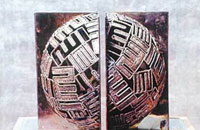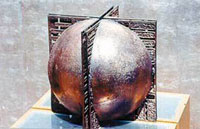17 December 2003
Charbagh
by Bina Shah
The Gardens of Amin Gulgee
 Amin Gulgee opened his latest sculpture exhibition, Charbagh (Four Gardens), this summer at his gallery, located near the Clifton beach, down the hill from the Park Towers mall. The gallery houses the works of both Gulgee and his father, the world-renowned painter. I was invited to the opening, and made my way there in the early part of the evening, which was still sweltering enough to give the illusion of the city having become a gigantic open-air sauna. The humid air of the beach had invaded the normally air-conditioned interiors of houses and shops, drinking the moisture right out of people’s skin like a particularly thirsty vampire.
Amin Gulgee opened his latest sculpture exhibition, Charbagh (Four Gardens), this summer at his gallery, located near the Clifton beach, down the hill from the Park Towers mall. The gallery houses the works of both Gulgee and his father, the world-renowned painter. I was invited to the opening, and made my way there in the early part of the evening, which was still sweltering enough to give the illusion of the city having become a gigantic open-air sauna. The humid air of the beach had invaded the normally air-conditioned interiors of houses and shops, drinking the moisture right out of people’s skin like a particularly thirsty vampire.
Entering Gulgee’s gallery is like stepping into a wonderful surrealistic painting in which odd shapes, images, and objects stare at you as you pass by, giving you the feeling that you’ve turned into Alice and are stepping into Wonderland. An odd stained glass sculpture made out of a mosaic of traditional Pakistani fan shapes greets you as you enter. Gigantic eyes and satellite dishes peer at you from various levels of the gallery, three stories tall. Nooks and corners present varying tableaux to delight or surprise you: ancient benches with a single tiny marble topped table; another astonishing sculpture worked right into the foundations of the house, a window that looks as though it’s encrusted in jewels; vines that climb all the way up the three stories of the house and clamber up to a rooftop garden.
This is the text from the brochure presented to us at the entrance:
“One of the greatest innovations the Moguls made in garden design was bringing the geometric grid or the Charbagh to the subcontinent. Previously, the gardens of which none survive, were rambling organic and unstructured. The Moguls with their central Asian roots brought the organized grid garden to house themselves and their elaborate entourage. The Charbagh, which literally means four gardens, has its roots in central Asia and Persia. There are central Asian myths of the four rivers of life intersecting at a point from which sprouts a cosmic tree and in Persian garden carpets evidence of the Charbagh can be found.
“The Charbagh in which two lines intersect at a perpendicular can define both a circle and a square. In Islamic symbolism some art historians have speculated that the circle denotes the divine and the square man. In three dimensions the circle becomes a sphere and the square a cube. In this body of work I have attempted to combine these pure forms which are diametrically opposite to each other. For me, the cube is finite and the sphere is infinite and there is inherent tension in their juxtaposition.
“Paradise in Islam is a garden. Will this cosmic garden be structured or is this just a metaphor for us decomposing and becoming part of the great garden of life? Having no answers I wait and try to discover my own balance with the infinity of the unknown.”
Studying the brochure more, I’m reminded that Gulgee earned his degree in Economics and Art History from Yale, but I learn that he received a Fine Arts award for his thesis on Mughal Gardens. He’s been exhibiting since 1988, all over the world: Pakistan, the United States, the Middle East, Europe. For such an accomplished artist, he is surprisingly down-to-earth; he runs around the gallery in a black T-shirt and jeans, smoking like a factory and enveloping favorite guests in huge bear hugs. “You must read the text, read the text,” he cries, practically opening the brochure and pointing it out to visitors. “Come here and look at this one. Go all around it,” I can hear him tell another group, who seem slightly bemused by his enthusiasm.
 The sculptures that Gulgee has presented in this collection are, in a word, stunning. Gigantic pieces of worked copper combined with other metals, glass, and even computer circuitry are mounted on huge bases, balanced on one perilous corner. They are made in variations on the theme of the twice-bisected square or the twice-bisected circle, becoming, in three dimensions, cubes and spheres. Some are worked with Islamic calligraphy in the boxy Kufic script; others are grids of harsh symmetry interspersed with gentler tracings – leaves, curlicues, coins. The entire feeling is one of movement and energy; the sharp planes of the squares’ edges draw your eye to all the different corners and points at once; the way the sculptures are balanced make you feel as though the sculpture will tumble down at any moment. It’s almost an optical illusion on a grand scale, when you see how strongly they are fastened to their bases.
The sculptures that Gulgee has presented in this collection are, in a word, stunning. Gigantic pieces of worked copper combined with other metals, glass, and even computer circuitry are mounted on huge bases, balanced on one perilous corner. They are made in variations on the theme of the twice-bisected square or the twice-bisected circle, becoming, in three dimensions, cubes and spheres. Some are worked with Islamic calligraphy in the boxy Kufic script; others are grids of harsh symmetry interspersed with gentler tracings – leaves, curlicues, coins. The entire feeling is one of movement and energy; the sharp planes of the squares’ edges draw your eye to all the different corners and points at once; the way the sculptures are balanced make you feel as though the sculpture will tumble down at any moment. It’s almost an optical illusion on a grand scale, when you see how strongly they are fastened to their bases.
There are some real standouts in the collection: a huge semi-circle hangs suspended from the ceiling by two wires, swaying gently in the breeze that blows in from the open doors to the courtyard. A gigantic, fifteen foot sculpture graces the main room of the gallery, ready to be snapped up by a bank or corporation; its soaring heights would only look good in a large, beautiful marble hall where indoor waterfalls tumble and escalators hum. Other pieces are smaller, more intimate, and amusing: two pieces where computer motherboards have been melted so that the gold chips combine with the copper that the artist has worked around their shapes. “This is a cool piece, look, it’s the Indus Valley hieroglyph,” says Gulgee, pointing to a small, ten inch copper piece delicately fashioned into an ancient, indecipherable letter. I can’t remember the names of the sculptures now, but there are red dots in front of at least half of them, indicating that they’ve been snapped up by mysterious buyers even before the show has opened.
The collection is breathtaking, and is groundbreaking, more so than the work he did for the group exhibition entitled Dish Dhamaka. Self-assured, confident, Charbagh has solid foundations based on Gulgee’s academic work, and more importantly, seems to have captured an important space – the juxtaposition between the ancient and the modern, between the tangible and intangible, the known and the unknowable. Its combination of modern materials and ancient themes make you think of a faraway heritage that can almost be transformed into a not-so-distant future.
The artist’s job is twofold: to express his own creativity, and communicate with his audience his inner vision, and to inspire others to look beyond the immediacy of their lives to a greater universal truth. Gulgee has introduced us to the gardens of his artist’s eye with this exhibition, in a way that is both highly personal and inspiringly visionary.
